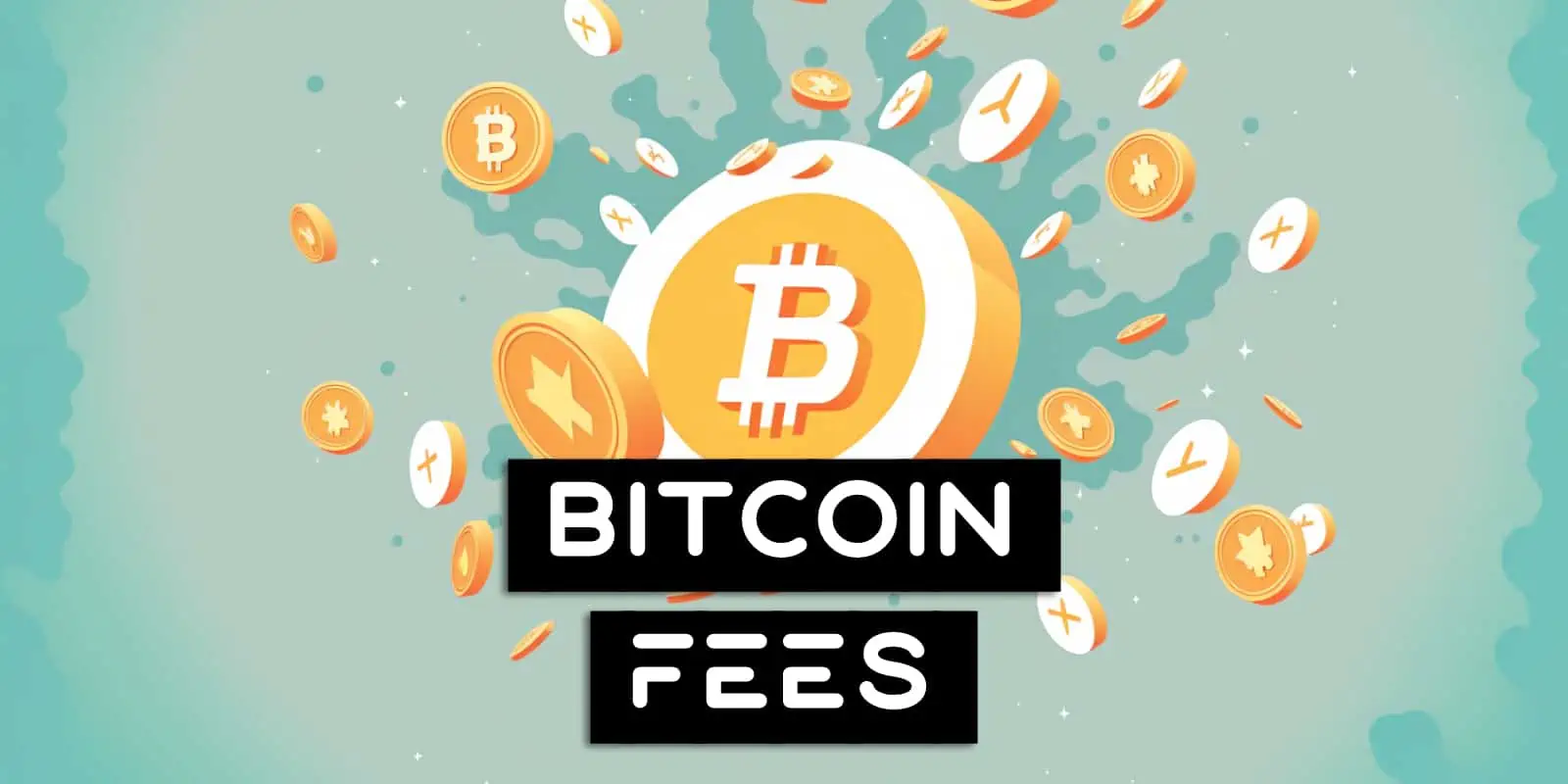Wondering why you have to pay Bitcoin transaction fees and whether or not you’re getting screwed?
We’re here to help.
Sending Bitcoin isn’t hard and neither is figuring out the right transaction fee. Most of the time the answer is literally just 1. We’re not even joking either! 1 sat/vB. Stop getting ripped off by listening to dodgy exchanges or bad wallet applications that insist you throw away your bitcoins and learn how to properly calculate the transaction fee so you save money and get your transactions confirmed quickly every time.
Note: Due to a new craze of “minting” other non-financial data to the Bitcoin Blockchain like JPEGs, the past few months have seen quite high fees. This article has been updated to take this into consideration and the below advice will help you save tons of sats!
Contents
What Are Bitcoin Transaction Fees?
Bitcoin transaction fees are what you as a sender pay to Bitcoin Miners in order to have your transaction included in the Bitcoin Blockchain. Unlike most transaction fees charged by banks, with Bitcoin you are free to choose your own fee which is normally represented in sats per virtual byte or “sat/vB”.
But how much are Bitcoin transaction fees really? Well over the past year, the average Bitcoin transaction fee that people have chosen has fluctuated greatly. This has mainly been due to the new craze of ordinals and inscriptions, so for most of the year it’s been around 50-200 sats/vB.
Given an average Bitcoin transaction has 2 inputs and 2 outputs that take up around 200vB, that equates to around 4,000-40,000 sats or $1.60-$16.80 USD per transaction. This is much higher than what it used to be in 2022, which was mostly around 1-10 sats/vB or about $0.06-$0.60! But regardless of the cost now, this can be reduced to essentially zero as we cover below.
The other truly amazing thing about Bitcoin transaction fees is that they’re not based on how much you’re sending. Instead they are only related to how big (in kilobytes) your transaction is. This means that you can send billions of dollars worth of Bitcoin value for that same $0.06 fee. This isn’t just theoretical either, here’s a transaction where someone sent over $1 billion dollars for just $0.70!
Bitcoin transaction fees are also different to the various fees and charges that exchanges or other brokerage companies charge to buy, sell and transfer bitcoins within their own ecosystems. So be aware that if you’re seeing two transactions, this can be why. One for the company / platform and one for Bitcoins base layer.
Below you can see an example of a simple Bitcoin transaction. You have 1 input on the left and 1 output on the right. The input is for 0.00059848 BTC while the output is for 0.00059408 BTC. The difference (0.00059848 – 0.00059408 = 0.0000044 BTC or 440 sats) is what the transaction fee is.
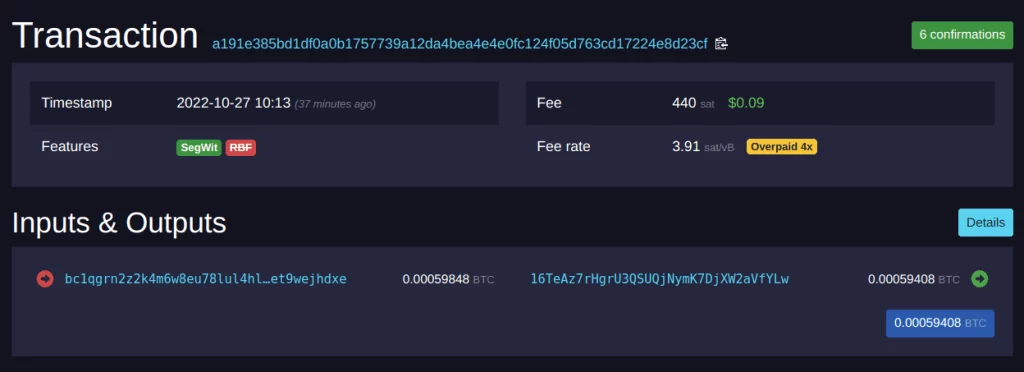
While no one likes paying fees, Bitcoin transaction fees are an essential part of the network as they prevent spam transactions from clogging up and slowing down the network. If it was “free” or extremely cheap to have your transaction added to the blockchain then an attacker could just spam a billion transactions and no one else would be able to use the Bitcoin network.
Also be aware that the fee you choose only impacts how quickly your transaction is confirmed in the first block. Once your transaction is confirmed in the first block, how long you wait for additional blocks doesn’t have anything to do with your fee. Each block confirmation on average will take 10 minutes so sometimes, even when you pay a high fee, you’ll still need to simply be patient.
Dive Deeper: How Long Does Bitcoin Take To Send?
Bitcoin Transaction Fee Calculator
Now that we understand what transaction fees are and why they exist, the next obvious question is what fee should you pay? As stated, there is no set fee. You as the sender get to decide but you don’t want to overpay as that would just waste money. As such there are many online transaction fee calculators or estimators that you can make use of.
These monitor the Bitcoin network and use their own special sauce to suggest what you should pay. One of the best resources for this is mempool.space as shown below. Not only does this visualize the Mempool (Memory Pool) and Bitcoin Blockchain well, but it gives excellent suggestions depending on what priority you’re seeking.
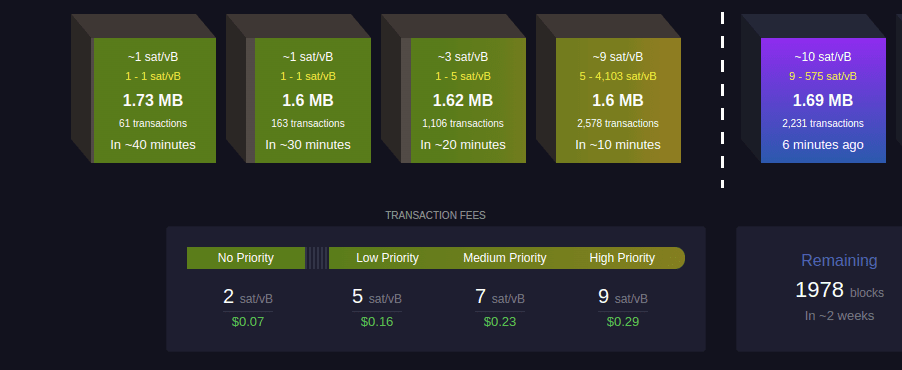
When you broadcast a transaction, you’re essentially entering into a bidding war with everyone else for block space. You want your transaction put into the next block (so it’s confirmed quickly) but so does everyone else! As such, when the miners pick which transactions to include, they will always pick the ones that are paying the highest fees as that gets them the most money.
Virtually all Bitcoin Wallets, exchanges or other pieces of software come with built in, automatic fee estimators or calculators. This means that if you don’t want to think about it, you can just let the wallet decide for you. There’s also many “user friendly” wallets that don’t let you chose your fee, these should be avoided though as you usually end up paying higher fees than you should.
Choosing the right fee for your transaction really depends on how quickly you need it to be confirmed. If you’re just sending some sats to yourself or a friend, then it’s probably not urgent and you can save money by setting it to “No Priority” or “Low Priority” value shown and having it take a while.
If on the other hand you’re making a purchase or doing something more time critical, then you will need it to be included in the next block meaning you should target the “High Priority” amount suggested.
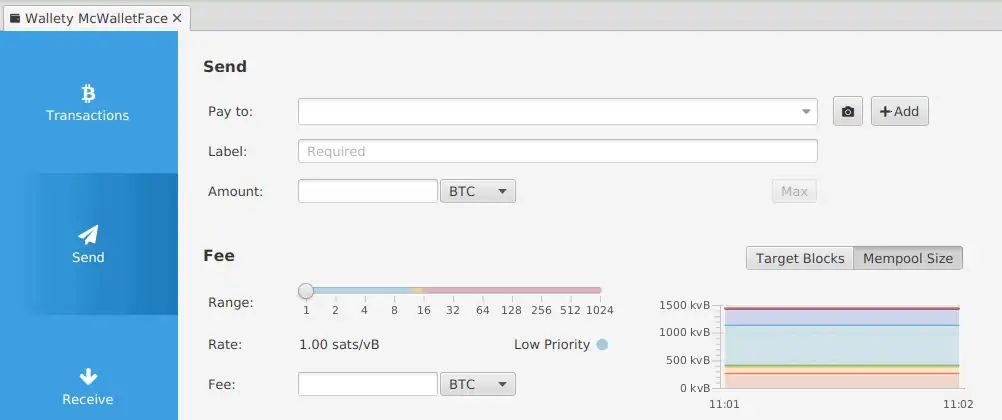
A good wallet such as Sparrow Wallet will automatically calculate the optimal fee for you, but also let you override it. This ensures that if you’re not in a hurry, you can just set the fee to a low sat/vB value and pay the lowest amount possible, even if it takes a while to be confirmed. For a more in depth look on transactions and timings, check out our piece on How Long Bitcoin Takes To Send.
How To Save On Bitcoin Transaction Fees
Bitcoin transaction fee calculators can be a fantastic thing, but also aren’t going to take into account your own personal situation. This means the best way to use them is to take their suggestions into account and then tweak the fee for your own specific case.
The top three ways to save on base layer Bitcoin transaction fees are to pick the right time, always check the mempool and reduce the size of your transaction. This can be done in seconds, isn’t hard at all and will save you literally thousands of sats over the years so it’s worth learning how to do it properly!
Pick The Right Time
As you’re competing with quite literally everyone in the world, the most crucial thing that determines how high fees are is timing. You wouldn’t intentionally go for a drive during peak hour traffic and Bitcoin is no different. Try and time your transactions at the least busiest times and you’ll have a much better (and cheaper) experience.
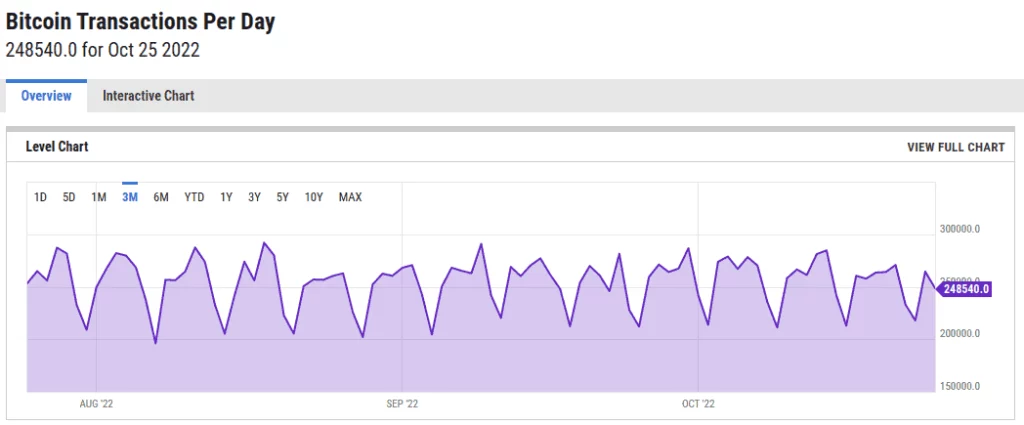
Although Bitcoin is a global network, many of the world’s largest cryptocurrency companies and users are based out of the USA. As such, you’ll usually find that the busiest times are when it’s the standard business hours of 9-5, Monday to Friday in the USA. So one of the simplest and easiest way to save on Bitcoin transaction fees is to just not send transactions during these busy times.
If it doesn’t matter when you send that transaction to your hardware Crypto Wallet or when you buy that widget with Bitcoin then just wait until the weekend. The mempool will likely be much quieter and you’ll get access to a much lower fee rate whilst still having your transaction confirmed quickly.
Check The Mempool
Next up is to always do a basic sanity check on what the Bitcoin Mempool looks like before setting your manual fee rate. Sometimes certain Bitcoin Wallets or fee estimators are just plain wrong. They might have a minimum value that they default to even if the mempool is completely dead and 1 sat/vB would get you confirmed in the next block.
As such it’s important just to give a quick look at the current state which again is easiest done through mempool.space. Technically you can set your fee to 0 sats/vB and it might still be confirmed in a block eventually, but it’s not recommended. Even if the mempool is completely dead still set it to at least 1 sat/vB as that way it won’t get stuck forever.
New to Athena Alpha? Start today!
Reduce The Size Of Your Transaction
As outlined above, Bitcoin fees aren’t based on how much money you’re sending, but instead on how big (in bytes) your transaction is. This is because the more bytes a transaction is, the more of the block space it takes up. While you can send a billion dollars for five cents, sometimes wallet software will construct a transaction that isn’t very efficient costing you dearly when transferring your bitcoins.
The size of your transaction is mostly dependent on how many inputs and outputs (or UTXO’s) you have in it. Inputs take up more space than outputs so the fewer of them you have, the fewer bytes (or virtual bytes) you will take up meaning a cheaper overall fee.
Each input Bitcoin Address can be multiple different types and some older legacy ones such as Pay To Pubkey (P2PK) take up much more block space (30%+) than newer ones like Pay-to-Witness-Public-Key-Hash (P2WPKH), also called Native SegWit. Again this results in you paying an overall higher fee. You can learn more about addresses in What Is A Bitcoin Address.
If you’re wanting to send a large amount of bitcoin (say 1 BTC for arguments sake as you’re a baller) and you have this amount made up of many, smaller 0.1 BTC UTXOs, then when the transaction is created it will naturally involve multiple inputs.
Even if you set the fee to be 1 sat/vB, because there are so many inputs (10 in this case) the total size of the transaction will be much larger and thus, it’ll cost you more to send your bitcoins. Often this can’t be avoided, but sometimes it can be if your wallet has Coin Control. This allows you to select specific UTXO’s to include in the transaction.
So in the example above, maybe you chose the 1.2 BTC UTXO instead of the 10 x 0.1 BTC UTXO’s resulting in a much smaller transaction size and thus, fee. Alternatively, you could select inputs that use the more modern SegWit address type which again will save you block space and thus, fees.
How To Make Bitcoin Transactions Faster
Unfortunately the only way to make your Bitcoin transaction get confirmed faster is to jack up the fee rate. Again, no one likes paying fees, but at least with Bitcoin 100% of those fees you pay are going directly to the Bitcoin Miners that are providing you with a critical and useful service.
But what if you don’t want to pay $16.80 for your transaction? Or maybe you don’t want to wait the 10 minute to 1 hour it takes to have your transaction confirmed in 6 blocks? A lot of people throw shade at Bitcoin for its expensive or slow transactions, but you don’t have to go use some other shitcoin to get lightning fast transactions anymore. Just use the Lightning Network!
While the Lightning Network is only a few years old, it’s more than capable of transferring almost any payment (in native bitcoins) essentially for free and instantly. You can send $100 for $0.0001 or you can send $0.0001! All transactions happen instantly and the fees are measured in sats they’re that small.
If you’ve just got a Lightning Wallet setup and want to make a test payment, we’d love your support and already accept Lightning Payments via our Support Us page! You can also Subscribe With Bitcoin (or Lightning) to Athena Alpha Pro too.
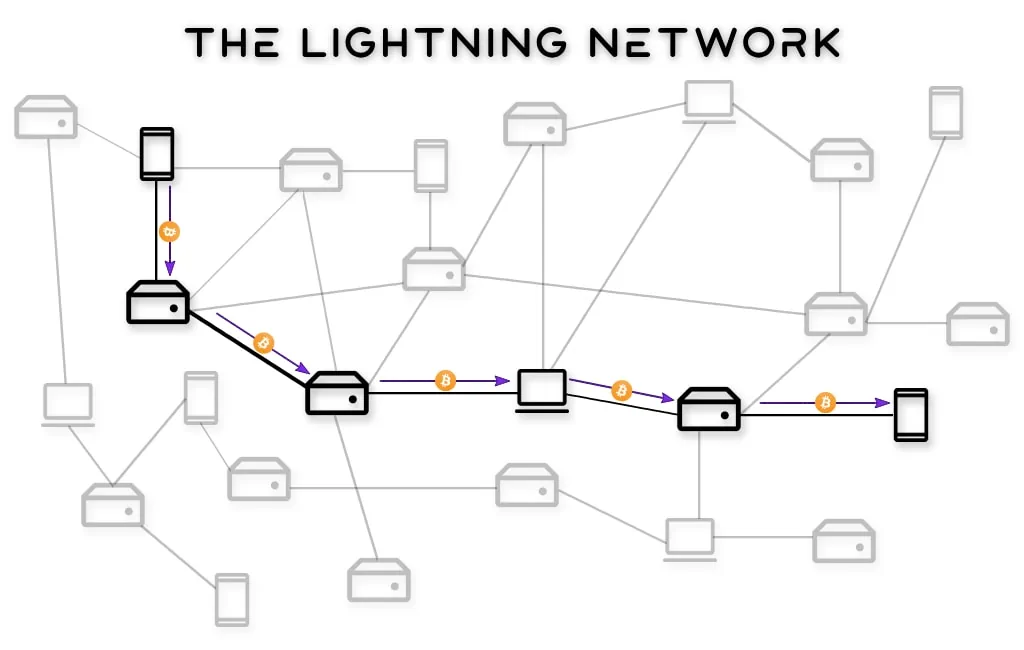
The Lightning Network uses what’s called Layer 2 technology to create payment channels between Lightning Nodes. These thousands of nodes connect together all over the world and route transactions off the Bitcoin chain. This sacrifices some security for much faster speed and lower fees.
The Athena Assessment
Bitcoin once again is a game changer when it comes to transaction fees. Unlike the tired old legacy financial rails it doesn’t matter if you want to send $0.0001 or $10 billion dollars. Bitcoin will do it far quicker and far cheaper than anything else out there.
The Lightning Network also opens up an absolutely huge potential when it comes to online commerce and creator applications. Are you a streamer or podcaster? Why not have sats streamed directly to your own Full Bitcoin Node for every minute one of your viewers is watching or listening to you? The possibilities are endless when it comes to What You Can Do With Bitcoin!
With Bitcoin you have every option available from the very small to the biggest ballers on the planet. You don’t have to get approval from anyone. You don’t have to submit to privacy invasive “checks” and you don’t have to wait for someone in meatspace to check your transaction before it gets approved. It can be 3 AM on a Sunday morning in NYE and Bitcoin will confirm that transaction on average every 10 minutes. Tick tock, another block.
How Much Are Bitcoin Transaction Fees?
Bitcoin transaction costs only depend on how big in bytes your transaction is. The more inputs and outputs you have, the more expensive your bitcoin fee will be. A simple transaction usually costs around 200-2,000 sats or $0.06-$0.60 USD. You can also pay virtually zero transaction fees by using the Lightning Network.
What Does Sat/vb Mean?
As transaction costs only depend on how big in bytes your transaction is, the fees are quoted in Satoshi per virtual bytes. This is abbreviated to sat/vB or sat/byte.
Where Do Bitcoin Transaction Fees Go?
No one likes paying fees, but with Bitcoin 100% of the transaction fee you pay goes directly to the Bitcoin Miners that are providing you with a critical and useful service. Exchanges may also charge an additional fee which doesn’t go to miners.
How To Make Money From Bitcoin Transaction Fees
The only way you can make money from Bitcoin transaction fees is to become a Bitcoin Miner. Miners are the ones that collect transactions into new blocks that they produce. As a reward for this service, they get to keep the transaction fees.
What’s The Bitcoin Transaction Fee For $100?
Bitcoin transaction costs only depend on how big in bytes your transaction is. As such, the dollar value you’re sending is irrelevant with Bitcoin. A simple transaction usually costs around 200-2,000 sats or $0.06-$0.60 USD which could be for $100 or $100 million dollars.
How Much Are Bitcoin ATM Fees?
Different Bitcoin ATMs charge different fees. Some charge a flat fee while most charge a percentage of how much you purchase. Recent reviews of various brands indicate that this percentage fee can be anywhere from 4-20%. Most ATMs charge around 10-12% though.

